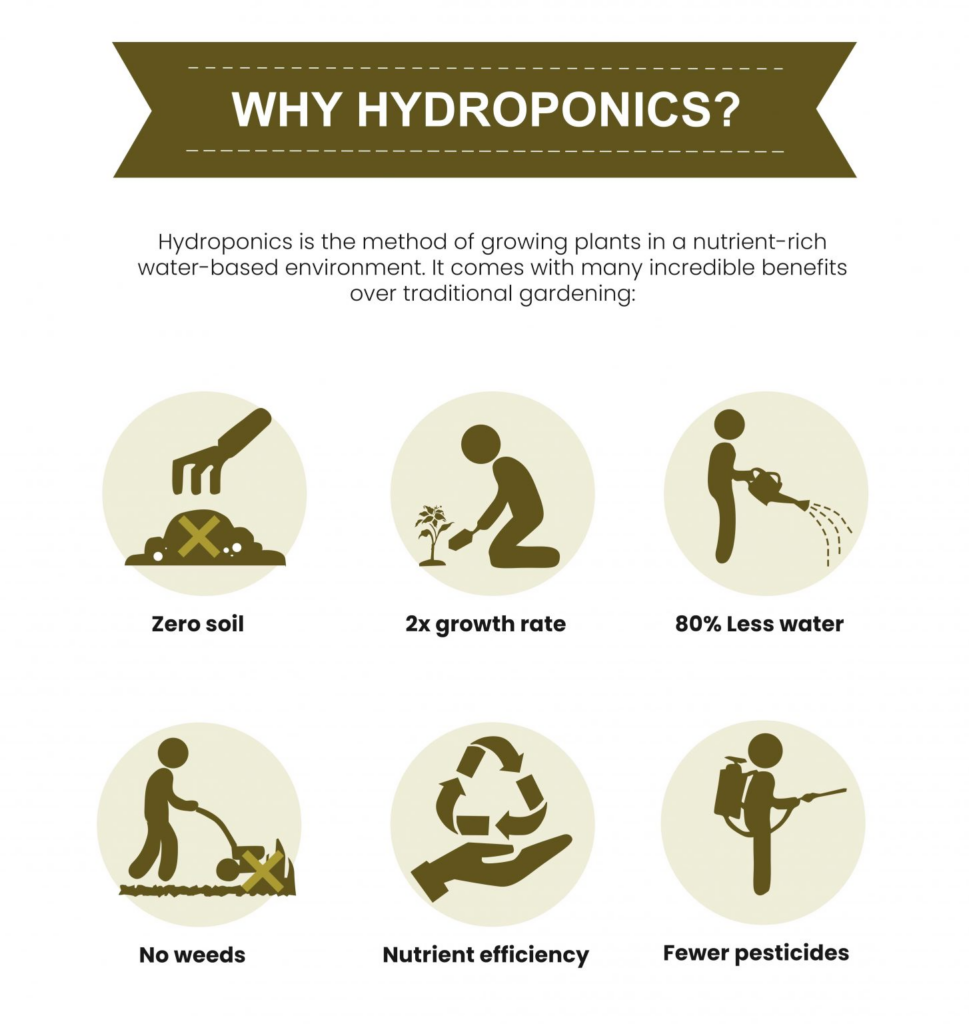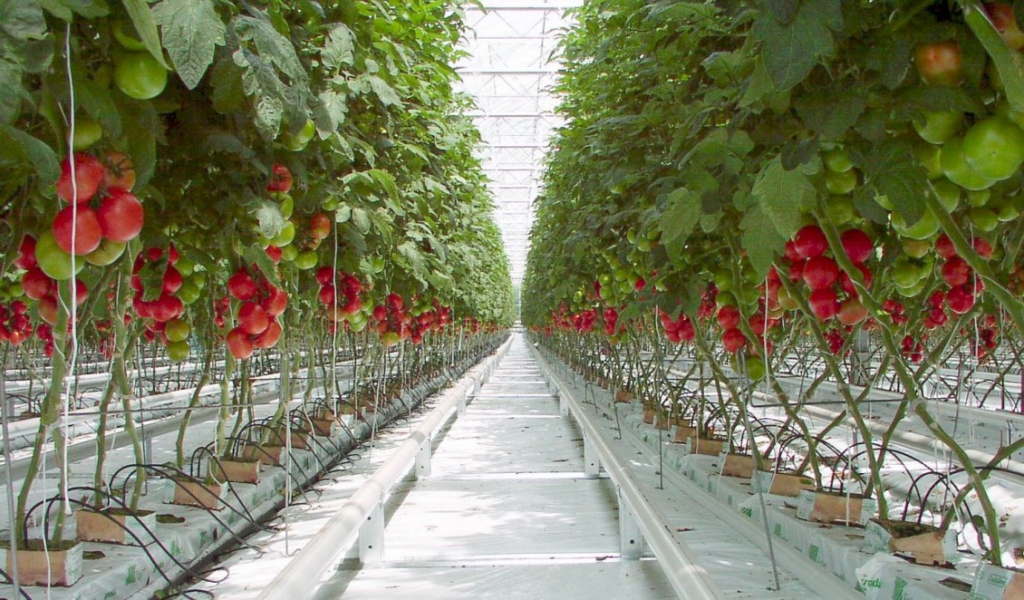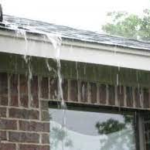Hydroponics has many benefits over the conventional soil-based method, including the ability to grow plants in less space, use less water and chemicals, and produce larger harvests. However, hydroponic farming may be time-consuming, costly, and susceptible to water-borne illnesses.
Over the years, people’s curiosity about the process used to create their food has substantially increased.
More customers demand “safe” food that is grown using sustainable, thoughtful farming techniques and is devoid of pesticide residues. Because of this, more people are preferring to grow their food, and many of them are looking into hydroponics.
Hydroponics, often known as soilless agriculture, is a way to grow plants without using traditional soil by giving them the necessary nutrients and water right to their roots.
This innovative approach has gained popularity for its potential to optimize plant growth, especially for people who live in urban settings and do not have enough space for agriculture, while minimizing the drawbacks associated with soil-based cultivation.
If you’re considering starting a hydroponics project, you should first familiarize yourself with the basic principles of hydroponically growing plants. On this page, you’ll discover the basics, as well as the advantages and disadvantages of hydroponics.
What Is Hydroponics?

Hydroponics is a technique used in growing plants indoors without any soil. Plants are able to get all of their nutrition through a nutrient solution that is delivered to their roots, as opposed to drawing the mineral minerals required for growth from the ground.
Depending on the kind of plants you want to cultivate, you can add nutrients to the water, such as calcium, phosphorus, nitrogen, potassium, and many more.
One of the incredible advantages of hydroponics is that it can be used in an array of situations, from raising a few plants in a large-scale commercial operation to a tiny collection of herbs in a kitchen.
Hydroponic growth is highly beneficial to people who have little or no outdoor space, such as city dwellers, apartment dwellers, or renters who are unable to have an outdoor garden.
The finest plants to grow in a hydroponics system include herbs, lettuce and greens, tomatoes, peppers, and strawberries. Generally speaking, avoid plants that grow tall like maize, have deep taproots like potatoes, or grow in a vining manner.
Advantages of Hydroponics
Apart from being beneficial to your health, Hydroponics farming is also helpful to the environment. Here are the key advantages of hydroponics.
1. Increased Growth Rate
One of the most significant advantages of hydroponics is the accelerated growth rate and high yield of plants. With direct access to nutrients, plants can grow 50% faster than their soil-grown counterparts. This is most likely caused by the elevated oxygen levels in the nutrition solution and the managed environmental elements.
You can encourage root development and improve nutrient uptake by raising the oxygen levels in a plant. Less stress on plants and a more abundant yield result from these ideal growing circumstances.
2. Water Efficiency

Water conservation is one of the top listed advantages of hydroponics farming, which benefits the farmers. Hydroponic systems are highly efficient in water usage.
They use up to 90% less water compared to traditional soil-based cultivation, making them a sustainable choice in water-scarce regions.
The hydroponics method provides the nutrients in their dissolved state, in water, directly to the plant. This eliminates the loss of water due to absorption by soil.
Also, in most hydroponics systems, the nutrient solution is continuously re-circulated and recycled. This mechanism ensures that water (and its dissolved nutrients) is not wasted.
An obvious benefit of minimal water consumption in hydroponics is the fact that natural resources (water and nutrients) are conserved. This is beneficial to the ecosystem and is a step in the direction of sustainable development
3. Space Savings
One of the advantages of hydroponic systems is that they allow farmers to grow more plants in the same amount of space while using less space than soil-based techniques.
Hydroponics conserves space through vertical cultivation, whereby plants are grown in rows within a regular-design hydroponic framework, making it ideal for urban gardening and limited spaces.
The vertical farming approach also allows for higher plant density and efficient space utilization.
4. Optimal Nutrient Control
Hydroponics involves the direct provision of nutrients to plants with minimal loss.
The overall setup of hydroponics is advantageous in terms of how nutrients are provided for and absorbed by plants.
Growers have complete control over the nutrient composition, enabling them to tailor it to specific plant needs. This precision minimizes the risk of nutrient deficiencies or excesses.
5. Fewer Pests and Diseases
Because hydroponics systems are indoors, they are less susceptible to soil-borne pests and diseases. This reduces the need for pesticides and promotes healthier plant growth.
6. Year-Round Growing with Bigger Harvests
Hydroponic farming often produces more per square foot than soil farming because more plants may be grown in fewer places. With controlled indoor environments, hydroponics allows for year-round cultivation, eliminating the limitations imposed by seasonal changes.
7. No Need for Soil in Hydroponics
The fact that there is no need for soil in hydroponics makes it one of the primary advantages of hydroponics. Agricultural land is becoming a scarce resource, especially as a result of the growth of the global population, which is associated with rising demand for food and residential land.
However, with hydroponics, land (which is an important natural resource) can be conserved, and at the same time, problems of food insecurity due to land shortage can be addressed. These are reasonable steps toward achieving sustainable development.
Also, some problems associated with conventional, soil-based agriculture can be addressed using hydroponics. Such problems include soil testing and suitability requirements and natural hazards like landslides and erosion.
Disadvantages of Hydroponics

It is easy to see the advantages of hydroponics. However, certain distinct disadvantages of hydroponics exist. As with anything, it’s critical to comprehend the cons to prevent unpleasant surprises.
1. Initial Setup Costs
Compared to a traditional garden, Setting up a hydroponic system can be expensive, requiring investments in equipment, lighting, and nutrient solutions. However, long-term savings may outweigh these initial costs.
2. Maintenance Requirements
There is a lesser need to keep observing the plant growth in conventional farming as Mother Nature does all she can to make the plants grow. However, in hydroponic systems, there is a demand for consistent monitoring and maintenance.
pH levels, nutrient concentration, and water quality must be regularly checked and adjusted. This is one of the major disadvantages of hydroponics, as minor negligence can result in the death of the plant you nurtured.
3. Technical Knowledge and Experience
One of the disadvantages of hydroponics to be taken into account is the need for technical knowledge and experience. Successful hydroponics requires a certain level of technical expertise.
Novice gardeners may face a learning curve in mastering the intricacies of nutrient management and system operation.
However, there are different kinds of machinery and techniques used that farmers need to be made aware of. Therefore, they need to learn before laying their hands on the hydroponic farming process.
It would help if you were keen to learn, adapt, and master the whole process, which can be burdensome.
4. Vulnerability to Power Outages
Both passive and active hydroponics systems are reliant on electricity for lighting, and pumps can be vulnerable to power outages.
Also, Using a hydroponics system introduces some of the problems commonly associated with energy consumption. These include the risk of electric hazards, overheating of the surroundings by electric components like the growing lights, and malfunctioning of the system.
5. Risks Of Water and Electricity
Two significant factors in Hydroponic farming are electricity and water. So, unless you have adequate water or stable electricity, the Hydroponic system won’t thrive well.
In addition, you will also need to stick to proper safety precautions to prevent electrical hazards and impair the plant’s condition at different stages of growth. All these are things you seldom ever have to worry about when doing regular farming.
6. Water-Borne Diseases
Since hydroponically grown plants are cultivated in water rather than soil, the prevalence of water-borne illnesses is significantly higher.
Infections can swiftly spread across the growing system as a whole, impacting the entire collection of plants due to the system’s continual water circulation. In extreme circumstances, a water-borne illness might quickly wipe out all the plants in a hydroponics system.
7. Limited Crop Selection
While many plants can thrive in hydroponic systems, some species are more challenging to grow hydroponically. Certain root vegetables and larger fruiting plants may need to be better suited for this cultivation method.
8. Lack of Soil Buffering
For soil, buffering capacity is simply the ability to resist change. This resistance to change often occurs in the form of the absorption of excessive materials that can offset the physicochemical equilibrium of the soil.
Soil buffering helps to maintain nutrient availability, moisture, and pH of the soil within manageable limits.
The absence of soil in hydroponics farming means that the regulation of these parameters must be done artificially. This places hydroponic plants at risk of the negative consequences of errors that may occur in the process.
Conclusion
As the world grapples with food security and environmental concerns, hydroponics presents a promising solution, provided farmers are prepared to put time and effort into mastering this innovative cultivation method.
Ultimately, the decision to embrace hydroponics should be guided by an understanding of its advantages and disadvantages in the context of individual goals and resources.









